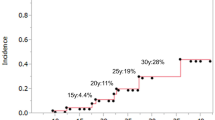Abstract
We collected 51 cases of stricture in the upper portion of the biliary tract and discussed the pathogenesis and the clinical significance of the strictures. All 51 patients had congenital cystic dilatation of the common bile duct (CCDB): 2 had infant-type cysts which involved the choledochus and/or the common hepatic duct, and 49 had adult-type cysts which included the entire extrahepatic bile duct and/or the main intrahepatic bile ducts. Thirty-five of the latter 49 had intrahepatic bile duct stones proximal to the stricture. Considering the location and the clinical features, the strictures may have been formed congenitally. Furthermore, adult-type cysts of the common bile duct with strictures in the upper portion of the biliary tract are thought to be the basis for the formation of primary intrahepatic bile duct stones.
Résumé
Sur 51 cas de sténose de la portion supérieure du tractus biliaire sont discutées la pathogénie et la traduction clinique des rétrécissements. Les 51 patients présentent une dilatation kystique congénitale de la voie biliaire principale, 2 d'entre eux ayant un kyste de type infantile englobant le cholédoque et/ou le canal hépatique commun, et 49 ayant un kyste de type adulte englobant la totalité des voies biliaires extrahépatiques et/ou la plupart des canaux biliaires intrahépatiques. Parmi ces 49 patients, 35 présentent des calculs des canaux biliaires intrahépatiques à proximité de la sténose. En raison de la localisation et des symptômes cliniques, les sténoses pourraient avoir une origine congénitale. De plus, le kyste de type adult de la voie biliaire commune avec rétrécissement dans la portion supérieure du tractus biliaire pourrait être à l'origine de la formation de calculs dans les canaux intrahépatiques primitifs.
Resumen
Se presentan 51 casos de estenosis de la porción superior del tracto biliar y se discute la patogenesis y la significación clínica de estas lesiones. Todos los 51 pacientes tenían dilatación congénita de canal colédoco (DCCC), e incluyen 2 con quistes de tipo de recien nacido que afecta el colédoco y/o el hepático común, y 49 con quiste de tipo adulto que afecta la totalidad de los canales biliares extrahepáticos y/o los principales canales intrahepáticos. Treinta y cinco de los últimos 49 casos tenían cálculos en los canales intrahepáticos proximales a la estenosis. Al considerar la localizatión y las características clínicas, se puede pensar que las estenosis sean de formatión congénita. Además, el quiste del colédoco de tipo adulto con estrechez en la porción superior del tracto biliar es propuesto como base para la formación de cálculos primarios de los canales intrahepáticos.
Similar content being viewed by others
References
Chen, H.U., Zhang, W.H., Wang, S.S.: Twenty-two year experience with the diagnosis and treatment of intrahepatic calculi. Surg. Gynecol. Obstet.159:519, 1984
Nakayama, F., Koga, A.: Hepatolithiasis: Present status. World J. Surg.8:9, 1984
Chang, T.M., Passaro, E.: Intrahepatic stones: The Taiwan experience. Am. J. Surg.146:241, 1983
Cheng, F.C.Y.: Primary cholangitis. Hong Kong Practitioner2:178, 1980
Balasegaram, M.: Hepatic calculi. Ann. Surg.175:149, 1972
Itai, Y., Araki, T., Furui, S., Tasaka, A., Atomi, Y., Kuroda, A.: Computed tomography and ultrasound in the diagnosis of intrahepatic calculi. Radiology136:399, 1980
Matsumoto, Y., Uchida, K., Nakase, A., Honjo, I.: Clinicopathologic classification of congenital cystic dilatation of the common bile duct. Am. J. Surg.134:569, 1977
Araki, T., Itai, Y., Tasaka, A.: Computed tomography of localized dilatation of the intrahepatic bile ducts. Radiology147:733, 1981
Matsumoto, Y., Uchida, K., Nakase, A., Honjo, I.: Congenital cystic dilatation of the common bile duct as a cause of primary bile duct stone. Am. J. Surg.134:346, 1977
Norman, O.: Studies on hepatic ducts in cholangiography. Acta Radiol. [Suppl.]84:1, 1951
Glenn, F., Moody, F.G.: Intrahepatic calculi. Ann. Surg.153:711, 1961
Gray, S., Skanddlakis, J.E.: Embryology for Surgeons. Philadelphia, W.B. Saunders, 1974. p. 217
Author information
Authors and Affiliations
Rights and permissions
About this article
Cite this article
Matsumoto, Y., Fujii, H., Yoshioka, M. et al. Biliary strictures as a cause of primary intrahepatic bile duct stones. World J. Surg. 10, 867–874 (1986). https://doi.org/10.1007/BF01655262
Issue Date:
DOI: https://doi.org/10.1007/BF01655262




